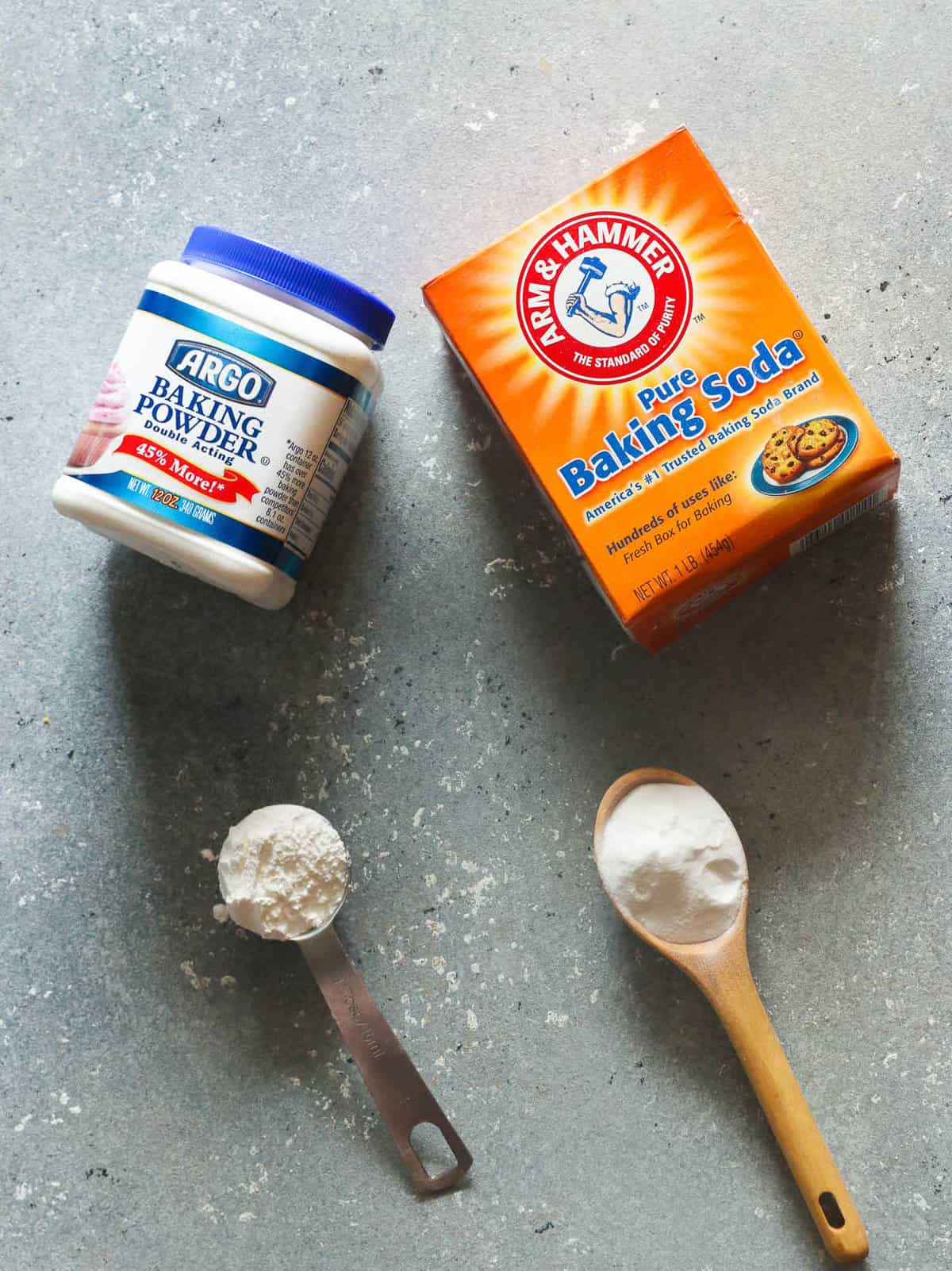Baking Soda vs. Baking Powder – An age-old question every new baker has asked, myself included. Both are white and powdery, both are leavening agents, and their names even sound similar. So here’s what you need to know about baking soda and powder to keep your baked goods coming out perfect every time.

Your recipe asks for baking powder, but you only have baking soda. “Can I sub one for the other?” you ask yourself. They look the same, right? Half an hour later, you’ve got some cranberry orange scones that aren’t quite right. Disappointing…believe me, I know!
Fortunately, you can learn from my mistakes without repeating them! 😅 While baking is indeed more of an art, there is still some science involved. However, you don’t need a chemist’s degree to understand how baking powder and baking soda are similar and different and when to use them both.
Content…What is Baking Soda? |
What Is Baking Soda?
Baking soda (sodium bicarbonate or bicarbonate of soda) is an alkaline salt compound that creates carbon dioxide gas when mixed with an acid. That makes your baked goods rise (think yogurt, honey, buttermilk, and lemon juice).
Baking soda is way stronger than baking powder, 3-4 times as strong! 💪 (Gives new meaning to Arm & Hammer’s logo, doesn’t it?) That means you don’t need as much in your recipe. In fact, if you overdo it, baked goods will taste metallic or soapy.
What Is Baking Powder?
Baking powder contains baking soda, but it has more. Cream of tartar provides acidity, and cornstarch typically keeps it from activating too soon. While it doesn’t need acid to activate, it does require heat and moisture.

Baking Powder vs. Soda: What’s the Difference?
- Basically, baking soda needs to mix with acid to create carbon dioxide and is used in recipes that call for acidic ingredients.
- Baking powder, on the contrary, already contains acid, so it’s used in recipes that don’t use a significant amount of acid.
⚠️ Here’s your takeaway: Baking soda and baking powder are not the same, and they are not interchangeable.
FAQs
It has to do with a chemical reaction affecting the flavor of your recipe. Baking soda, in essence, neutralizes acidic ingredients. So if you’re aiming for that buttermilk tang in your buttermilk biscuits, baking soda might neutralize it.
On the other hand, baking powder might not be powerful enough to give your biscuits the perfect rise. So a careful balance of both leavening agents will give your baked goods a fluffy texture while retaining the tangy flavor profile. 🙌
You could use baking powder instead of baking soda, but you’ll need to use quite a bit more, around a teaspoon of powder for every ⅓ teaspoon of soda. Depending on the recipe, that could give you a bitter tasting baked good. You may need to leave out acidic ingredients or substitute them to compensate. For example, replace buttermilk with whole milk.
If baking soda is all you have, you can mix 1 teaspoon baking soda with 2 teaspoons cream of tartar, and you’re ready to measure for your recipe.
Yes, you absolutely can. Mix 1 tablespoon (12 grams) baking powder and ½ teaspoon (2 grams) salt into 2 cups (250 grams) of flour.
How to Use Them
- Use baking soda to leaven baked goods when one or more acidic ingredients are in the recipe. For example, buttermilk, yogurt, sour cream, or vinegar.
- Baking powder works best as a leavening agent when a recipe doesn’t contain acidic ingredients, like a basic vanilla cake.
- Both together balances out the rising factor with the acidic ingredients.
- Add baking powder to your favorite spice mix when making chicken wings if you want them extra crispy.
- Determining which to use, when, and how much can be pretty complex if you are just experimenting. 🤯 If you are working off a recipe, it’s usually best practice to use the amounts the recipe creator has already established.
How to Store Them
Baking soda and baking powder have limited lifespans and can lose their effectiveness. Unused powder or soda sealed in airtight containers at room temperature should last anywhere from six months to a year.
How do you know if they’re active? For baking soda, put a teaspoon into a small bowl of vinegar or lemon juice. If it fizzes and bubbles, it’s still good. If not, it’s time to buy a fresh container.
For baking powder, put ½ teaspoon in a small bowl and pour a little boiling water over it. If it’s still fresh, it too will bubble vigorously. A small amount of bubbles or a bowl of hot water that’s totally flat means it’s time to throw it out.
More Kitchen Pantry Staples You Need in Your Life
- Homemade Breadcrumbs
- All-Purpose Seasoning
- Homemade Buttermilk
- Canola Oil Substitutes
- Homemade Vanilla Extract
- Clarified Butter
Conclusion
Well, that solves the baking powder vs. baking soda mystery, and it has everything to do with acid! Who would’ve thought? How do you remember which leavening agent to use in your baked goods? I’d love to hear your tips in the comment section below. 🫶

Allen says
Baking powder has aluminum in it. Which is known to cause alzheimers. It best to find something without aluminum in it.
Imma says
Thank you for pointing that out. I’m not a doctor or scientist, but definitely use aluminum-free if you can find it.
Sue Kartzmark says
I have learned so much from your posts and recipes. I would like to let you know in your “,how to test baking soda and powder” you have only baking soda listed I think you have a typo the second test should be for powder please correct me if I am wrong
Imma says
Yes, you caught me. I’ve already fixed it. Thanks:)
Glen says
Great explanation on both. Thanks:)